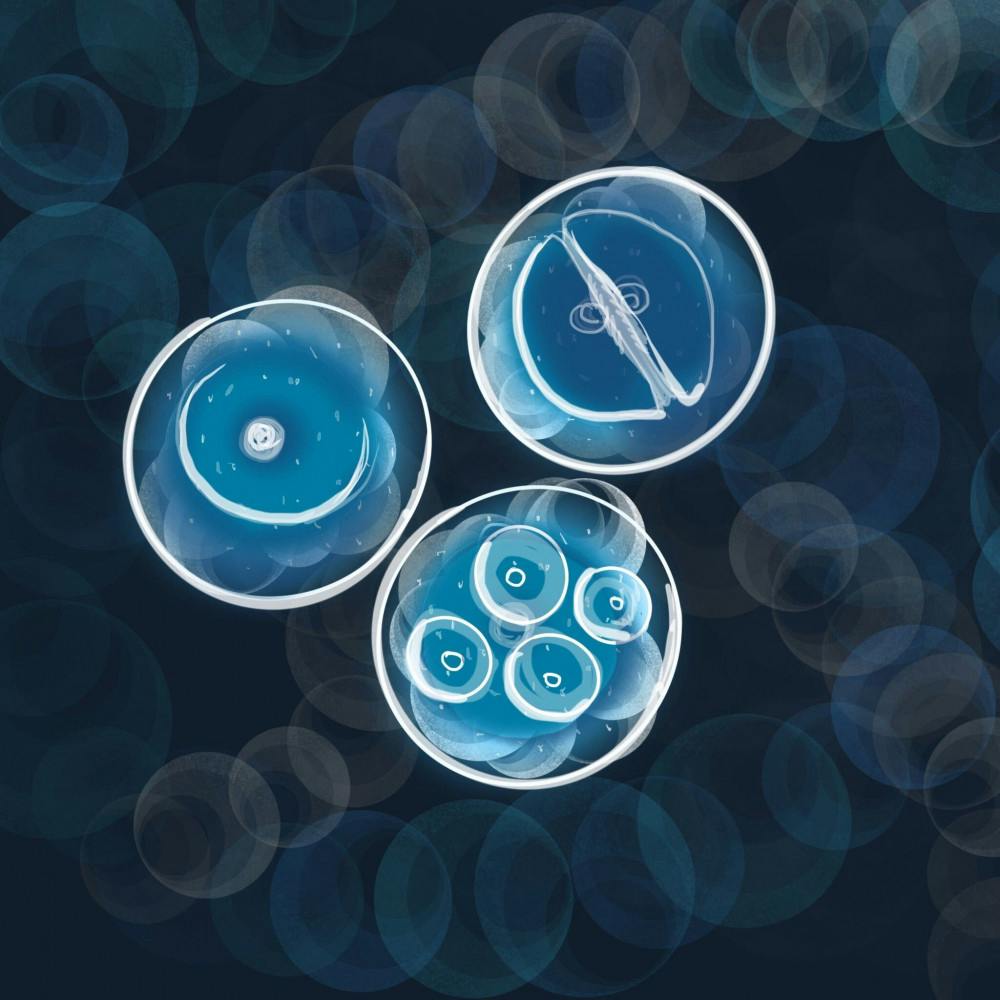Elementary schoolers learn that DNA is the instruction manual for life — the immutable blueprints that cells follow to build proteins and stay alive.
But DNA is a physical molecule which can change over time. So how do cells, especially the ones which produce offspring, ensure that these blueprints stay safe and functional?
In a virtual seminar hosted Wednesday by the Graduate Program in Molecular Biology, Cell Biology and Biochemistry, titled “Asymmetric Stem Cell Division and Germ-line Immortality,” Yukiko Yamashita, a professor of life sciences at the University of Michigan, explained how her research resulted in a serendipitous connection between two fields of cell biology.
Yamashita typically studies asymmetric cell division, the process by which a daughter cell will split off from the original cell to specialize for a certain function, while the original cell will remain a stem cell capable of any function.
But a series of deductions and experiments on this process led Yamashita to an insight on the mechanisms of germline immortality.
Germline immortality refers to the fact that certain cells act as vessels for storing and passing down genetic information. Since these cells will carry similar genomes across generations, they can be thought of as immortal, Yamashita said. However, the mechanisms that protect this immortality are currently poorly understood. Yamashita hopes to change that through her research.
Yamashita started by working to answer a simple question: When a stem cell divides, how is the fate of the divided cells determined?
Using fruit flies’ testes as a model to examine stem cells and differentiated cells, which will specialize into different functions like sperm or other tissue, Yamashita’s lab began by examining the latter.
They first determined that a common feature of asymmetric stem cell division was the presence of a mother centrosome, a cellular component which regulates the destination of genetic material during division.
Swathi Yadlapalli, who is currently an assistant professor at Michigan’s Department of Cell and Developmental Biology but worked in Yamashita’s lab at the time, then determined that chromosomes, which would typically assort randomly between the divided cells, were in this case dividing non-randomly.
Specific chromosomes, the X and Y sex chromosomes, would regularly assort toward the mother cell, thereby breaking a fundamental rule of cell division: chromosomes assort randomly. Investigation of these oddly assorted chromosomes found a specific region vital to this activity.
Surprisingly, this region was composed of ribosomal DNA, the coding regions for parts of ribosomes, which are responsible for synthesis of proteins.
“If you look at any of your cells, any transcriptionally active cell, 60 percent or more of the entire transcription activity is from ribosomal DNA,” Yamashita said. “You can’t do that high demand of transcription off just a single copy of the gene. For that reason, ribosomal DNA genes are repeated hundreds of hundreds of times in our genome.”
rDNA is inherently unstable. As cells age, the rDNA will decay, decreasing the availability of ribosome production sites and ultimately impacting the cell’s function.
For germ cells, which must preserve genetic information to pass on through generations, this erosion poses a threat to long-term reproductive viability. But organisms have demonstrated the capacity to somehow recover from this loss and produce offspring with more rDNA sites than the previous generation.
Yamashita’s lab proposed a mechanism by which the odd non-random assortment observed earlier could replenish rDNA sites, ultimately increasing the cells’ ability to pass on their genes.
Typically, chromatids, pairs of identical chromosomes, align equally during division. An event called crossing over results in the random swapping of material on two parallel chromatids.
Yamashita realized that chromatids were purposely misaligning and crossing over.
“That was a thunderstrike moment for us,” Yamashita remembered. “This is the asymmetry we have been looking (at) for quite some time. Probably, when we say non-random chromatid segregation, this copy-number asymmetry might be what can explain this.”
While Yamashita’s lab has yet to prove this mechanism, they can detect an unequal crossing over of these regions, as well as hypothesize as to the origins of the signal which leads to the intentional misalignments.
Yamashita related that her lab’s advances were due to a willingness to “listen to the data,” as she puts it.
Yamashita added that, oftentimes, scientists will run experiments repeatedly, each time encountering the same, implausible data. “If you keep getting that data, multiple times, that is the moment that data is screaming at you,” Yamashita told The Herald. “‘You are wrong! You are on the wrong track.’ You really have to face this puzzling data.”
Germline immortality was not the typical work of the Yamashita Lab, but after following the breadcrumbs left by investigation of asymmetric cell division, she found herself on the path toward new conclusions.
“That’s the way I do my science,” she said. “If there’s data that’s puzzling (and) controversial but you cannot ignore it, you have to tackle it.”
Over 60 audience members virtually attended the hour-long seminar. Questions bubbled in the chat throughout the talk.
Although Yamashita reflected that a virtual environment can lead to difficulties for newcomers to assimilate into the scientific community, she pointed to cost and time benefits making virtual scientific events much more accessible.
Mark Johnson, director of the Graduate Program in Molecular Biology, Cell Biology and Biochemistry, also pointed to the benefits of a virtual seminar. “We find that some students and participants feel more comfortable asking questions by chat” than they would in person, Johnson said. Virtual events can also “bring in a much more diverse and interesting audience, without having the expense of time and travel.”

ADVERTISEMENT




